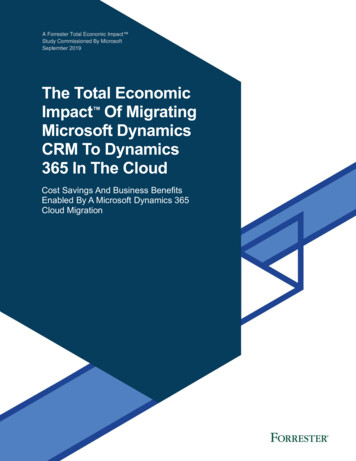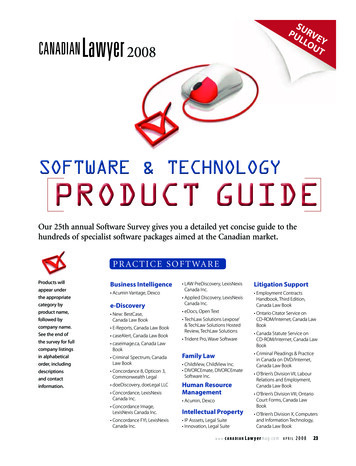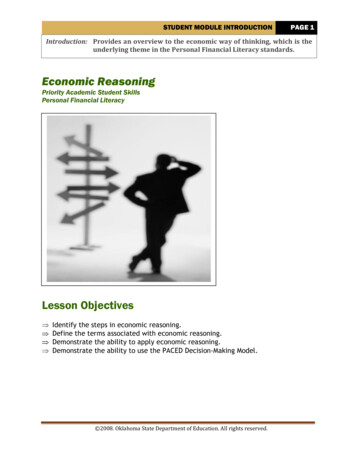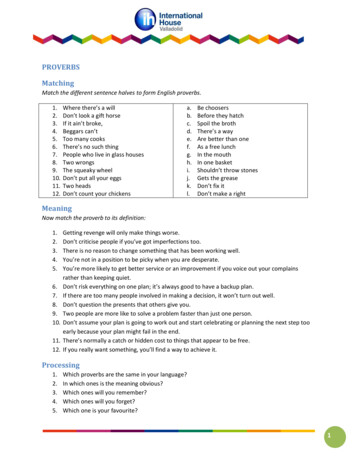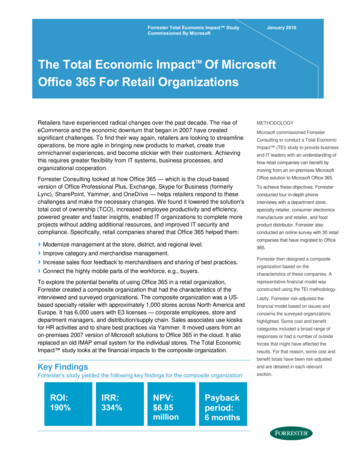
Transcription
35Forrester Total Economic Impact StudyCommissioned By MicrosoftJanuary 2016The Total Economic ImpactTM Of MicrosoftOffice 365 For Retail OrganizationsRetailers have experienced radical changes over the past decade. The rise ofeCommerce and the economic downturn that began in 2007 have createdsignificant challenges. To find their way again, retailers are looking to streamlineoperations, be more agile in bringing new products to market, create trueomnichannel experiences, and become stickier with their customers. Achievingthis requires greater flexibility from IT systems, business processes, andorganizational cooperation.METHODOLOGYForrester Consulting looked at how Office 365 — which is the cloud-basedversion of Office Professional Plus, Exchange, Skype for Business (formerlyLync), SharePoint, Yammer, and OneDrive — helps retailers respond to thesechallenges and make the necessary changes. We found it lowered the solution'stotal cost of ownership (TCO), increased employee productivity and efficiency,powered greater and faster insights, enabled IT organizations to complete moreprojects without adding additional resources, and improved IT security andcompliance. Specifically, retail companies shared that Office 365 helped them:Office solution to Microsoft Office 365.› Modernize management at the store, district, and regional level.› Improve category and merchandise management.› Increase sales floor feedback to merchandisers and sharing of best practices.› Connect the highly mobile parts of the workforce, e.g., buyers.companies that have migrated to OfficeTo explore the potential benefits of using Office 365 in a retail organization,Forrester created a composite organization that had the characteristics of theinterviewed and surveyed organizations. The composite organization was a USbased specialty retailer with approximately 1,000 stores across North America andEurope. It has 6,000 users with E3 licenses — corporate employees, store anddepartment managers, and distribution/supply chain. Sales associates use kiosksfor HR activities and to share best practices via Yammer. It moved users from anon-premises 2007 version of Microsoft solutions to Office 365 in the cloud. It alsoreplaced an old IMAP email system for the individual stores. The Total EconomicImpact study looks at the financial impacts to the composite organization.representative financial model wasMicrosoft commissioned ForresterConsulting to conduct a Total EconomicImpact (TEI) study to provide businessand IT leaders with an understanding ofhow retail companies can benefit bymoving from an on-premises MicrosoftTo achieve these objectives, Forresterconducted four in-depth phoneinterviews with a department store,specialty retailer, consumer electronicsmanufacturer and retailer, and foodproduct distributor. Forrester alsoconducted an online survey with 30 retail365.Forrester then designed a compositeorganization based on thecharacteristics of these companies. Aconstructed using the TEI methodology.Lastly, Forrester risk-adjusted thefinancial model based on issues andconcerns the surveyed organizationshighlighted. Some cost and benefitcategories included a broad range ofresponses or had a number of outsideforces that might have affected theresults. For that reason, some cost andbenefit totals have been risk-adjustedKey Findingsand are detailed in each relevantForrester’s study yielded the following key findings for the composite organization:section.ROI:IRR:NPV:190%334% 6.85millionPaybackperiod:6 months
The Five Benefit Pillars And Results SummaryForrester looked at retail company business and IT benefits across five broad areas. These pillars, asMicrosoft defines them, encompass business transformation, cost savings, and employee productivity gains.In each pillar, we explored the various ways that the interviewed and surveyed retail organizations havebenefited from moving their employees to Office 365. We also included at least one example from each pillarin the ROI analysis portion of the study. All of the responding companies experienced benefits across theareas highlighted in Figure 1.Figure 1Microsoft Office 365 Benefit Pillars And Risk-Adjusted Financial BenefitsSource: Forrester Research, Inc.The financial results calculated in the Benefits and Costs sections can be used to determine the return oninvestment (ROI), internal rate of return (IRR), net present value (NPV), and payback period for thecomposite retail company’s investment in Microsoft Office 365.The table below shows the risk-adjusted ROI, IRR, NPV, and payback period values.Results SummaryCostsBenefitsNet benefitsROIIRRPayback periodInitial( 1,172,821)Year 1( 1,335,327) 2,257,860 922,533 728,256( 444,565)190%334%Six months (after go-live)Year 2( 834,831) 4,047,867 3,213,037Source: Forrester Research, Inc.Page 2Year 3( 710,999) 5,778,662 5,067,663Total( 4,053,978) 12,812,646 8,758,668PV( 3,610,882) 10,467,796 6,856,914
The graph below shows the risk-adjusted cash flow.Figure 2Risk-Adjusted Cash FlowSource: Forrester Research, Inc.“We have benefited from Office 365 in many ways. Because it is acomplete cloud solution, we have seen infrastructure savings, easiersupport, and improved security. That said, the whole way people workhas become more productive, and they can find answers 24x7. That isthe biggest benefit we’ve seen.” Group manager, food retailerBenefitsFor each of the above pillars, the interviewed retail companies and online survey respondents spoke tomultiple benefits. In each area, Forrester quantified at least one benefit that is specifically highlighted andcomprises the ROI analysis component of thisstudy.Technology BenefitsIn interviewing and surveying retail companies,Forrester uncovered that these companies realizedthe following benefits by moving to Office 365compared with an on-premises solution:›››A 10.7% reduction in Microsoft licensing costs.A 12.6% reduction in third-party license andsoftware costs, e.g., other email solutions andantispam software.“We are saving 500,000 peryear in data center operationscosts and reduced capitaloutlays by 9.5 million overeight years.” Director of shared services, specialty retailerA 9.1% reduction in IT support costs for legacy systems.Page 3
In addition, Forrester quantified five benefit areas within the technology pillar:›››››The composite retail company avoided adding new infrastructure hardware. The move from the 2007version of the Microsoft solutions to the Office 365 cloud-based solution meant that the organization did notneed to purchase, install, and maintain new infrastructure. In total, 54 highly virtualized physical servers werenot added over the life of the study, and storage area network (SAN) requirements were reduced by half. Thisbenefit also includes an annual 750 saving per server, which includes data center hosting costs and labor tomaintain, update, and patch the physical servers. The total three-year risk-adjusted savings to purchase,maintain, and host the hardware amounted to 1,074,353.Server licenses for various Microsoft solutions were no longer needed. An on-premises solutioncomparable to Office 365 would have required 301Windows Server licenses, 21 Exchange Server“Previously, we had to maintainlicenses, three Skype for Business Server licenses,and 13 SharePoint licenses. The total three-yearall this infrastructure internally.risk-adjusted avoided purchase cost plus annualAll of this effort now goes intomaintenance totaled 113,768.The implementation effort was 43% less than fora comparable on-premises solution. Had thecomposite organization implemented a traditionalon-premises deployment of Microsoft 2013solutions, the internal effort and professionalservices fees would have been 50% and 40%greater, respectively. This total three-year riskadjusted savings across all phases equaled 527,263.creating value for the company.Also, the security featurespresent in Office 365 are reallyimpressive and eliminated thatwork for us as well.” Group manager, food retailerThe personnel required to support the solutionwere reduced significantly. The total number of personnel required to maintain and grow the Microsoftsolutions — Office Professional Plus, Exchange, Skype, SharePoint, Yammer, and OneDrive — in terms ofsystem administration and management of user accounts was reduced significantly. This was in the form ofavoiding two additional hires for Skype for Business and SharePoint as well as redeploying two existing emailsystem administrators who could focus on other, higher-value activities. The total three-year risk-adjustedassociated savings was 940,500.The composite retailer eliminated its third-party antispam and email solutions. The composite companywas spending 30,000 per year on an antispam filtering solution. This was eliminated with capabilities builtinto Office 365. There was also a very old IMAP email solution that was used for employees at stores, whichwas replaced with Office 365. The total three-year risk-adjusted associated savings was 71,250.In the interviews, Forrester heard more specifics about some of the technology benefits achieved. Onecompany told us: “We used to have a team of four who spent most of their time monitoring email systemsand keeping it running. With Office 365, our downtime has decreased and our team can work on adding newfeatures. That has been a very pleasant surprise.” Another said: “The business benefits a lot from us stayingup to date on the latest technologies. We used to spend a lot of time working on issues that would not haveexisted had we been on the latest release. We now save money and downtime, and we don’t need to haveengineers up in the middle of night patching.”Table 1 highlights the total quantified technology benefits for our composite retail company.Page 4
Table 1Total Technology BenefitsRef.Benefit CategoryInitialYear 1Year 2Year 3Atr Avoided backend hardware 390,038 291,240 189,405 203,670Btr Avoided Microsoft server licenses 41,337 41,214 15,312 15,905Ctr Reduced implementation effort 296,882 230,382 0 0Dtr Reduced IT support effort 0 104,500 418,000 418,000Etr Eliminated third-party technologies 0 14,250 28,500 28,500 728,256 681,585 651,217 666,075Total technology benefitsSource: Forrester Research, Inc.Mobility BenefitsThe interviews uncovered that these retail companies benefited from improved productivity for mobileworkers, as well as anywhere, anytime access to information for other knowledge workers. Some of the rolesthat especially benefit are district and regional managers, who are often visiting stores; buyers who arevisiting overseas suppliers; and merchandizers who are visiting stores. One interviewee said: “Merchandizingindividuals and account managers who go to the retail stores to check on what is happening, set up shelves,etc. have really benefited. They rely 100% on their mobile devices and now have access to all of theinformation they need.”From the survey, Forrester learned that 52% of theretail companies said Office 365 had improvedworker effectiveness and decreased businessprocess times; 48% said they had improved fastertime-to-market due to mobile access; and 45%reported that mobile access had created greater enduser productivity due to improved communicationsand knowledge sharing.“I have 150 district managerswho are always on the go. Nowthey always have access toanything they need viaOneDrive, SharePoint, andemail. Previously, if they werenot at one of our stores, theywould have to VPN in. It’sdefinitely faster to find theInternet than one of our stores.”For the financial analysis, Forrester looked atimproved productivity for 300 mobile workers,growing to 650 by Year 3 of the study. This groupcomprises mainly district and regional managers,merchandizers, and buyers. The reduction in time toaccess systems and information improves theirproductivity; since a VPN is no longer neededbecause of direct access via IPv4 and IPv6, they can Senior IT manager, department store operatornow access these systems from wherever they are,even at very remote sites. Office 365 also providesthese users with a more seamless user experience across devices with less downtime, which also improvestheir mobile productivity.In Year 1 of the study, the weekly time savings is 2.5 hours. This increases to 3.75 hours per week by Year3, as Skype and SharePoint are fully integrated and employees become more comfortable working in thisnew paradigm. This productivity gain can be used to create more content and sell more ad space, or it canbe a source of cost savings through avoided additional hiring. Forrester discounted this benefit by 50% sincenot all productivity gains translate into additional work.Page 5
As there are a variety of forces that could affect productivity outcomes within a retailer, this benefit was riskadjusted and reduced by 15%. The risk-adjusted total benefit resulting over the three years was 4,007,617.Table 2Increased Mobile Worker ProductivityRef.MetricCalculationYear 1Year 2Year 3F1Number of workers300500650F2Hours per day saved with use ofOffice 365 on mobile devices0.500.500.75F3Average hourly salary 42.50 42.50 42.50F4Number of workdays per year250250250F5Percent of benefit realized50%50%50%FtIncreased mobile workerproductivity 796,875 1,328,125 2,589,844 677,344 1,128,906 2,201,367 85,000/2,000 hoursF1*F2*F3*F4*F5 15%Risk adjustmentFtrIncreased mobile workerproductivity (risk-adjusted)Source: Forrester Research, Inc.One interviewed retailer also shared the specific example of buyers not having to make as many trips to Asiafor sourcing discussions. In addition to the cost savings, there is an IT security benefit associated with Office365. One interviewee explained: “Some of the countries we go to are known for trying to access visitors’laptops. We give people going to these countries a plain vanilla laptop without any sensitive information on it.They access everything via OneDrive and SharePoint, which is safely residing at home. Our audit andcompliance teams really like this capability.”For the financial analysis, Forrester assumed that there are 20 buyers making one less trip a year to Asia.The average cost for airfare, hotel, and per diem is 5,000 per trip. Since the number and cost of trips varygreatly across retailers, this benefit was risk-adjusted and reduced by 10%. The risk-adjusted total benefitresulting over the three years was 270,000.Table 3Fewer Sourcing TripsRef.MetricCalculationInitialYear 1Year 2Year 3G1Number of affected buyers202020G2Number of fewer trips111G3Average cost per trip 5,000 5,000 5,000GtFewer sourcing trips 0 100,000 100,000 100,000 0 90,000 90,000 90,000Risk adjustmentGtrG1*G2*G3 10%Fewer sourcing trips (riskadjusted)Source: Forrester Research, Inc.Control And Compliance BenefitsControl and compliance includes regulatory compliance, eDiscovery, audit, policy management, IT securitypolicies, and other similar activities. For retail companies, IT security is very important because hacking ofPage 6
customers’ personal and credit card information can lead to a lot of bad publicity, resulting in decreasedsales and increased liability. Forty-eight percent of survey respondents said it was easier to manage policiesacross all device types, 35% said they have seen improved enforcement of data retention policies with Office365, and 24% reported less time and effort spent on eDiscovery activities. We also learned that compliancecosts were reduced, on average, by 8.75%. The time spent on eDiscovery activities was reduced by 10.1%.Respondents also reported that the number and cost of data breaches decreased after they implementedOffice 365.In the survey and interviews, Forrester heard that Office 365 helped with meeting compliance requirementsfor:›PCI.›Data processing agreements (DPAs).›ISO 27001.›Sarbanes-Oxley (SOX).›››“PCI compliance is the biggestone for retailers. We useExchange protection to makesure credit card informationisn’t being sent.”Statements on Standards for AttestationEngagements No. 16 (SSAE 16). Senior IT manager, department store operatorCanadian Personal Information Protection andElectronic Documents Act (PIPEDA).OSHA.Forrester included two benefits in the control and compliance area. The first is less time spent on eDiscoveryactivities by the compliance teams. “Our ability to comply with legal holds has gotten a lot better. In the past,we journaled all our emails and stored them on secure disks. We had data corruptions all the time, andsometimes had to dedicate an exchange engineer to work with risk management. Now, our compliance teamis saving a lot of time. For a simple hold they save around 15 minutes, and for a complex one they save aday or two. We may have 3,000 holds at any one time, 100 of which are large events.”For the financial analysis, Forrester included the example given above. Each year there are 100 largeeDiscovery events and 3,000 holds in which time is saved. Since the number and complexity of events vary,this benefit was risk-adjusted and reduced by 10%. The risk-adjusted total benefit resulting over the threeyears was 223,763.Page 7
Table 4Reduced eDiscovery EffortRef.MetricCalculationYear 1Year 2Year 3100100100121212H1Number of large eDiscovery eventsH2Average time savings per event (hours)H3Number of annual email holds3,0003,0003,000H4Time saved per hold (hours)0.250.250.25H5Total time saved (hours)H1*H2 H3*H41,9501,9501,950H6Hourly average fully burdened business usersalary 85,000/2,000 hours 42.50 42.50 42.50HtReduced eDiscovery effortH5*H6 82,875 82,875 82,875Risk adjustment 10% 74,588 74,588 74,588HtrReduced eDiscovery effort (risk-adjusted)(16 hours - 4hours)Source: Forrester Research, Inc.The second area we looked at in the control and compliance pillar was reduced disaster recovery (DR) andbusiness continuity costs. This was a very strongbenefit for the interviewed organizations. Email systems“With OneDrive in place, weare generally considered mission-critical and more oftendon’t have to worry about losingthan not lack adequate business continuity and disasterrecovery capabilities. One interviewee said: “We did notanything anymore. Additionally,have redundancy in place before. If the Exchangewe don’t have to spend timeserver went down, people were down.”The amount of savings reported by the interviewees forthird-party DR solutions for email ranged from 100,000to 250,000. This benefit began in Year 2 after theexisting contract ended. We risk-adjusted this down 5%because the amount spent on DR solutions varies,resulting in a three-year risk-adjusted savings of 332,500.Page 8trying to retrieve lost files. Inthe past, losing files could havebeen disastrous.” Group manager, food retailer
Table 5Eliminated External DR CostsRef.MetricI1Eliminated external DR costsItEliminated external DR costsCalculation I1Year 2Year 3 175,000 175,000 175,000 175,000 166,250 166,250 5%Risk adjustmentItrYear 1Eliminated external DR costs(risk-adjusted)Source: Forrester Research, Inc.Business Intelligence BenefitsThe importance of business intelligence and the value of data within a retail organization company havebecome more important over the past several years. With multiple sales channels, increased competition,and shorter product design life cycles, understanding what is going on in the business and making timelydecisions is critical to success. One interviewee said: “We have certain business units that are using thefeatures of Office 365 to better understand their business, primarily in private brands and corporate supplychain. Some of them are also using the free version of Power BI.”Fifty-two percent of survey respondents said that employee performance has improved because they havebetter access to information through company portals. Forty-one percent said that employee performancehas improved because they have access to company portals and actionable information, anytime, anywhere.Additionally, 41% also reported a decrease in “time-to-decision” and said that the average reduction was15.25%.For the composite organization, Forrester looked at the increased productivity of 200 employees (increasingto 450 by Year 3) who spend a good portion of their day making decisions or completing analyses of salesand inventory data. These include marketing and pricing analysts, district and regional managers, distributionmanagers, and executives. In Year 1, these workers see an average savings of 1.25 hours per week. Asthey become more comfortable working with the features and utilize Office 365 more to aid their decisionmaking process, this increases to 3.75 hours per week by Year 3. This time savings can be used to completeadditional value-add work as well as avoid the need for new hires. Because not all time savings result inadded work, Forrester discounted this benefit by 50%. More importantly, but not included in the financialanalysis, making better decisions can increase revenues and profitability.Since the number of affected employees as a proportion of all employees varies greatly from oneorganization to another, this benefit was risk-adjusted and reduced by 15%. The risk-adjusted total benefitover the three years was 2,652,930.Page 9
Table 6Reduced Decision-Making TimeRef.MetricCalculationYear 1Year 2Year 3J1Number of affected workers200400450J2Hours saved per day0.250.500.75J3Workdays per year250250250J4Total man-days savedJ1*(J2/8 hours)*J31,562.56,25010,546.9J5Average daily salary 85,000/250 workdays 340 340 340J6Total potential savingsJ4*J5 531,250 2,125,000 3,585,938J7Percent of benefit realized50%50%50%JtReduced decision-making timeJ6*J7 265,625 1,062,500 1,792,969Risk adjustment 15% 225,781 903,125 1,524,023JtrReduced decision-making time(risk-adjusted)Source: Forrester Research, Inc.Real-Time Communications BenefitsThe way individuals live their personal lives in terms of using online social interaction services and other realtime communication tools is affecting how peoplecommunicate and collaborate in the workplace. A“The primary users of Yammermajor component of Office 365 is enabling theseinteractions to improve knowledge sharing,are sales managers. They use itcollaboration, and productivity. Interviewed retailto communicate best practicescompanies reported that the real-timecommunication tools and features improve theiracross locations and shareworkplace. These features allow the organizationsto create better shopping environments, quicklyphotos for special displays.”adapt to changing tastes, and share best practices Senior IT manager, department store operatoracross many geographically disparate locations.The interviewed companies shared with us thevariety of ways they are using these features to improve their business. For example, we heard: “We recentlyacquired a new brand and need to set up a meeting with their sales team to share our marketing plans.Without Skype, we would have needed to have multiple meetings, with people driving all over the place. WithSkype, we could do it all in one fell swoop, which saved us a lot of time and travel.” Another intervieweeprovided examples of the distribution facilities coordinating in real time via Yammer when the picking lineswere down.There are many ways that the real-time communication features of Office 365 can have an impact on anorganization. For the quantified portion of the real-time communication benefits pillar, Forrester looked at twoareas. The first is the hard cost savings from eliminating other webconferencing solutions. The second areais the improved processes to disseminate information to stores and share best practices between them.The investment in Office 365 eliminated the need for the composite organization to continue to invest inwebconferencing solutions provided by other vendors. Instead, scheduled and ad hoc meetings arePage 10
completed using Skype and Yammer. “With Skype for Business the world is changing,” said one interviewee.“We have eliminated all of our other video and desktop conferencing solutions.”These hard savings should be realizable by all organizations previously using other solutions forwebconferencing or audioconferencing. The size of the benefit increases beginning in Year 2, as previoussolutions are removed from different parts of the organization. Because costs vary based on usage andgeographic reach, this benefit was risk-adjusted and reduced by 15%. The risk-adjusted total benefit over thethree years was 228,000.Table 7Eliminated Communication TechnologyRef.K1KtMetricEliminated webconferencingsolutionEliminated communication costsRisk adjustmentKtrCalculation K1Year 1Year 2Year 3 60,000 90,000 90,000 60,000 90,000 90,000 57,000 85,500 85,500 5%Eliminated communicationcosts (risk-adjusted)Source: Forrester Research, Inc.Secondly, the investment in Office 365 improved how the composite organization disseminates informationto its retail stores and how it shares best practicesacross them. Previously, corporate staff and store“We recently acquired a newmanagers spent many hours each monthconsolidating information and sharing it. Thisbrand and needed to share ourinformation was not shared fast enough, and oftenimportant best practices were missed due to themarketing plan with their saleslack of process around sharing. Now, with Officeteam. Without Skype, this would365, these managers are easily able to shareimportant details in a timely manner.have required multiple meetingsFor the composite organization, Forrester looked atand people driving all over thethe reduction in time spent sharing information withthe 1,000 retail locations (increasing to 1,075 byplace. Instead, we were able toYear 3). Within these stores, Forrester assumesshare everything in one fellfive managers are affected at each location. In Year1, these workers see an average of 5 hours savedswoop, saving time and travel.”each month. As they become more comfortableworking with the features and utilize Office 365 Group manager, food retailermore to share best practices across locations, thisincreases to 10 hours per month by Year 2. Thistime savings can be used to complete additional value-add work. Because not all time savings result inadded work, Forrester discounted this benefit by 50%. More importantly, this can result in increased salesand/or profit margins.Since the number of affected stores and managers vary greatly from one organization to another, this benefitwas risk-adjusted and reduced by 15%. The risk-adjusted total benefit over the three years was 2,370,703.Page 11
Table 8Reduced Time Disseminating Information And Sharing Best PracticesRef.MetricCalculationYear 1Year 2Year 31,0001,0501,075L1Number of storesL2Average number of affected managers perstore555L3Hours saved per month51010L4Hourly fully burdened cost 85,000/2,000hours 42.50 42.50 42.50L5Total potential savingsL1*L2*L3*L4 1,062,500 2,231,250 2,284,375L6Percent of benefit realized50%50%50% 531,250 1,115,625 1,142,188 451,563 948,281 970,859LtLtrReduced time disseminating information andsharing best practicesRiskadjustmentReduced time disseminating informationand sharing best practices (risk-adjusted)L5*L6 15%Total Quantified BenefitsThe total quantified benefits, as well as present values (PVs) discounted at 10%, are shown in the tablebelow. Over three years, the composite retail company expects risk-adjusted total benefits to be a PV of 10.47 million.Page 12
Table 9Total Quantified Benefits (Risk-Adjusted)Ref.Benefit CategoryInitialYear 1Year 2Year 3TotalPresentValueAtr Avoided backend hardware 390,038 291,240 189,405 203,670 1,074,353 964,354Btr Avoided Microsoft server licenses 41,337 41,214 15,312 15,905 113,768 103,408Ctr Reduced implementation effort 296,882 230,382 0 0 527,263 506,320Dtr Reduced IT support effort 0 104,500 418,000 418,000 940,500 754,504Etr Eliminated third-party technologies 0 14,250 71,250 57,921 0 677,344 1,128,906 2,201,367 4,007,617 3,202,667Gtr Fewer sourcing trips 0 90,000 90,000 90,000 270,000 223,817Htr Reduced eDiscovery effort 0 74,588 74,588 74,588 223,763 185,488Itr Eliminated external DR costs 0 0 166,250 166,250 332,500 262,303Jtr Reduced decision-making time 0 225,781 903,125 1,524,023 2,652,930 2,096,661Ktr Eliminated communication costs 0 57,000Reduced time disseminatingLtr information and sharing bestpractices 0 451,563 948,281 970,859 2,370,703 1,923,636FtrIncreased mobile workerproductivityTotal benefits (risk-adjusted) 28,500 85,500 28,500 85,500 228,000 186,717 728,256 2,257,860 4,047,867 5,778,662 12,812,646 10,467,796Source: Forrester Research, Inc.While all of the benefits included in the ROI analysis are very important, Forrester looked at the softbenefits versus hard benefits delivered by Office 365. Hard benefits include specific external costsavings such as reduced license payments to Microsoft and discreet labor savings such as reducedimplementation time. Soft savings include general process efficiency gains that can improve theproductivity of many workers; this included Ftr, Jtr, and Ltr in Table 9 above. Approximately one-third ofthe benefits included fall into the hard category.Figure 3Hard Versus Soft BenefitsSource: Forrester Research, Inc.Page 13
CostsThe quantified costs include:›››››››Internal implementation labor. The full deployment of Office 365 was undertaken in two phases. Phaseone, completed in the initial period, consisted of standing up the Office 365 solution, migrating all emailaccounts and users to Exchange Online from Exchange 2007 on-premises, moving all users to Office 365Professional Plus from Office Professional Plus 2007 local clients, and deploying OneDrive for all users. Sixinternal FTEs worked on this for seven months. Phase two, completed in Year 1, consisted of a completelynew deployment of Skype for Business and Yammer, as well as migrating from SharePoint 2007 on-premisesto the latest version of SharePoint Online. Six FTEs worked on this for seven months. The total internalimplementation la
Server licenses for various Microsoft solutions were no longer needed. An on-premises solution comparable to Office 365 would have required 301 Windows Server licenses, 21 Exchange Server licenses, three Skype for Business Server licenses, and 13 SharePoint licenses. The total three-year risk-adjusted avoided purchase cost plus annual




